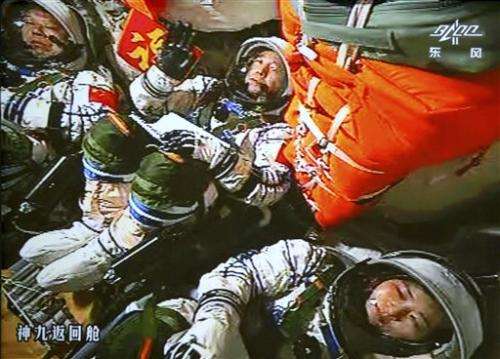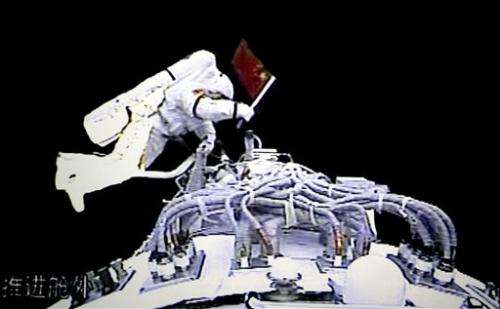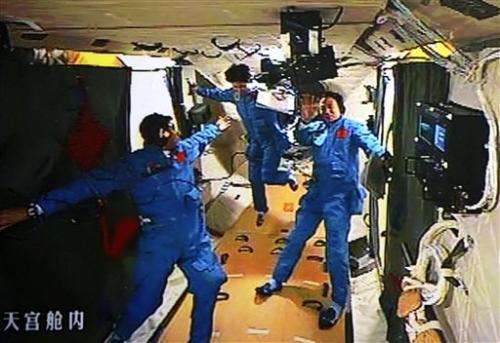China marks decade of human spaceflight (Update)

China's astronauts have braved the tension of docking with a space station and performed delicate tasks outside their orbiting capsule, but now face a more down-to-earth job that is perhaps equally challenging: Talking to young people about science.
Three Chinese astronauts will take flight this week, on Tuesday if weather permits, aboard a Shenzhou spacecraft to dock with China's Tiangong 1 space lab. On the heels of Canadian astronaut Chris Hadfield's wildly popular YouTube videos from the International Space Station, the Chinese crew plans to deliver a series of talks to students from aboard the Tiangong.
The lectures come as China's human space program enters its second decade, after going from a simple manned flight to space lab link-ups in a series of methodically timed steps in just 10 years. Meanwhile, its American rival, now in its sixth decade of putting people into space, continues its routine work on the International Space Station and long-term plans to go to an asteroid and eventually Mars.
"China is in space for the long haul. The U.S. ignoring that and refusing to work with China will neither stop them nor slow them down," said Joan Johnson-Freese, an expert on the Chinese space program at the U.S. Naval War College.
The Shenzhou 10 spacecraft—its name means "sacred vessel"—is to be launched aboard a Long March 2F rocket, a safer and more reliable version of that used in previous missions. It will transport the crew for a 12-day stay aboard the Tiangong 1, which functions as an experimental prototype for a much larger Chinese space station to be launched in 2020.
The space classrooms mark the boldest step so far to bring the military-backed program into the lives of ordinary Chinese and follows in the footsteps of NASA, which uses student outreach to inspire interest in space exploration and sustain support for its budgets. Thus far, Chinese astronauts have been paraded before the public at rallies and other events, but they've had almost no genuine interaction with ordinary Chinese.
The three-member team, announced on state media Monday and including one woman, will also conduct tests on the station's docking and life support systems, probing them for possible problems to be corrected in the design for the larger space station.
Although two Chinese spacecraft, one of them crewed, have already docked with the Tiangong, or "heavenly palace," since it was launched in September 2011, China's space program says its space station remains in mint condition.

China launched its first crewed mission, the Shenzhou 5, in October 2003, becoming the third nation after Russia and the U.S. to achieve that feat. The upcoming mission would be China's fifth crewed spaceflight.
Starting in 1992, China has trained a corps of 21 astronauts, including a younger cadre of seven men and women recruited over the past three years. Shenzhou 10's sole female member is Wang Yaping, a 35-year-old air force pilot whose earlier duties included seeding clouds in an attempt to clear the skies for the 2008 Beijing Summer Olympic Games.
Since the first 2003 manned mission, China has largely replicated the achievements of the U.S. and Russian programs but with updated technology and methodology. A single-man mission was followed by a two-man flight, then a pair of three-person flights, including the Shenzhou 9 that docked with the station and carried China's first female astronaut into orbit.
Though China has conducted fewer launches than the earlier U.S. and Soviet programs, it has recorded greater strides with each one, partly as a result of not having to conquer the great unknowns that challenged those programs.
"They don't have to reinvent the basic technologies for spaceflight," said Morris Jones, an Australian writer and space analyst who monitors the Chinese program.
While the material benefits of the Chinese program aren't always clear, it has brought China considerable international prestige, stimulated interest in science and engineering programs, and helped the military master new technologies in rocketry and remote guidance systems, Johnson-Freese said.

It also has allowed China to show some technical prowess and break away "from the image of a country that is best at producing knock-off designer shoes and handbags," she said.
The latest mission marks a turning point for the manned space program as it now shifts its target to launching the larger, three-module permanent station, Tiangong 2, seven years from now. The previous two missions to Tiangong 1 were considered experiments. From Shenzhou 10 on, they'll be treated as regular shuttle missions.
The future station will weigh about 60 tons, slightly smaller than NASA's Skylab of the 1970s and about one-sixth the size of the 16-nation International Space Station. China was barred from participating in the International Space Station, largely on objections from the United States over political differences and the Chinese program's close links with the military.
In the meantime, China is turning its attention to sending a rover to the moon. That could be followed by a crewed lunar mission if officials decide to combine the human spaceflight and lunar exploration programs, as Johnson-Freese says they are now considering doing.
China will focus for now on development of the Long March 5 heavier-lift rocket needed to launch the Tiangong 2, said Charles Vick, an expert on the Chinese and Russian space programs at GlobalSecurity.org.
"The focus is now shifting from the near-term to those future systems," Vick said, adding that the military continues to dictate priorities. "China's space program has been a very deliberately focused effort that focuses on specific science and technology goals."
© 2013 The Associated Press. All rights reserved.





















